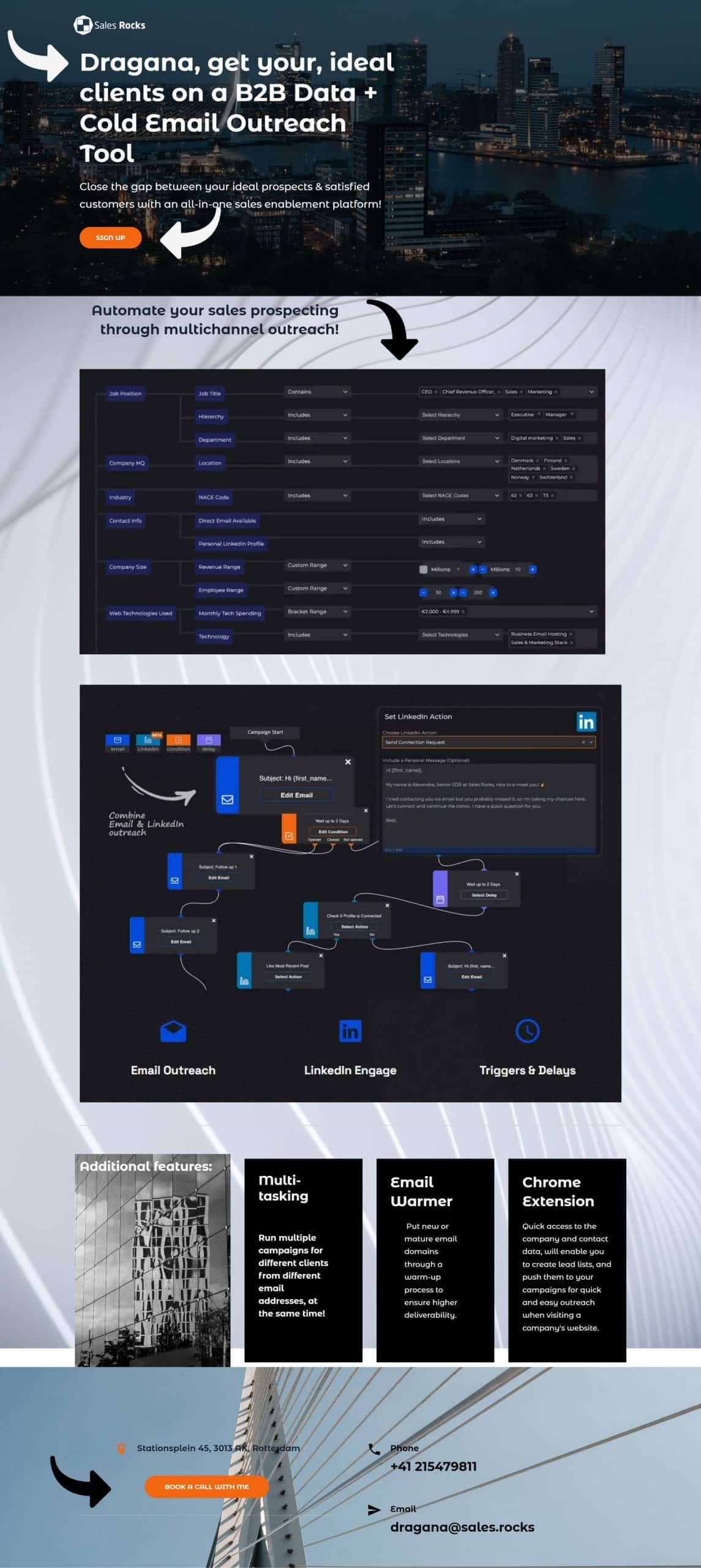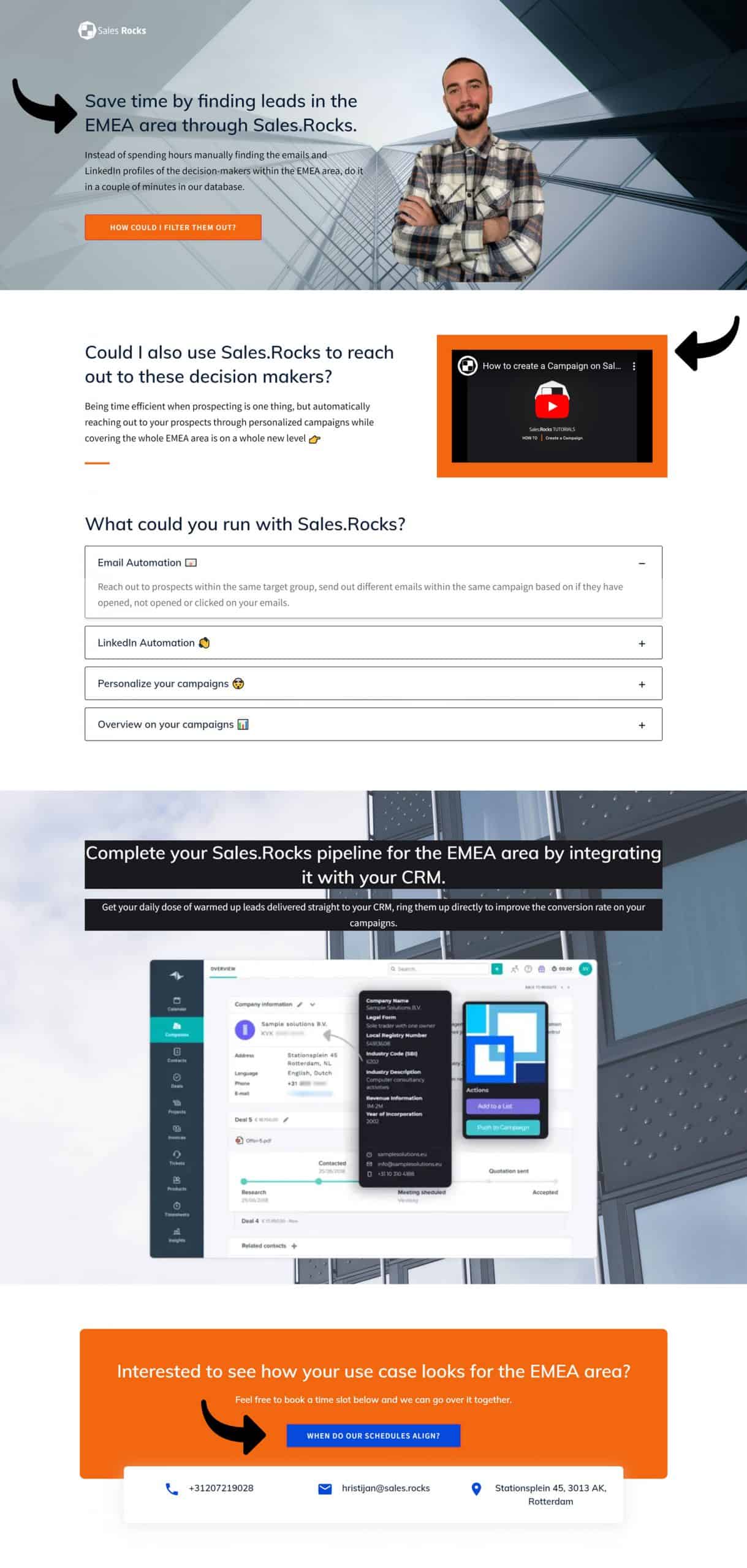Updated on April 5, 2023
Did you know that marketing landing pages are different from sales landing pages?
The main difference between these two is that, unlike all post-click landing pages, the purpose of sales landing pages is specifically to convince visitors to buy with specifically tailored content.
The long definition is that a sales landing page is specially customized and personalized for every person that receives and opens it, created to convert visitors into buyers, meaning that you need to be as precise as possible.
To achieve this, there are multiple things you can add to your landing page, including their name, company, focus the content on thier specific industry, and even add a dynamic image of thier company logo, or a screenshot of their website.
The short one is that sales pages are created to convince people that your solution was specifically designed to help them.
Moreover, sales landing pages are more flexible than traditional pages. They let you adjust, test, and update them before moving on to the remainder of the website.
For example, look at our SDR’s landing page.
At the start, you can see the headline and subheadline personalized for the person which the page is intended for, addressing the problem that your customer wants to solve, or the pain point you want to initiate to be solved.
Then, follows the CTA button and the part of the landing page which is designed to give the basic information that one needs to know about our company and services that we provide.


In the end, you can see the contact details, and another CTA so the customer can arrange a meeting or call with the SDR.
The most interesting part is the custom elements added to the landing page that target directly each of the visitors that is viewing the page.
The custom elements are dynamically changed displaying images/videos from the salesperson, name and company name of the customer, short video, etc.
So, do you want to connect with your leads humanly while automating your outbound process? Then, you should consider implementing these essentials to your sales landing pages.
Try Sales.Rocks
for hyper-personalized outreach
Get started today
The 3 rules
Make it fun, clear and straightforward!
I can guess that you don’t like reading some long and boring text when you open a page nowadays. And yes, I know what you are thinking – your customer doesn’t want that either! So be as precise as possible and try to have attention-grabbing, informative, persuasive text boxes and graphics that will be the highlight of your sales landing page.
Your sales landing page shouldn’t be too “designy”
Did you know that only 2,35% of the visitors will end up in conversions? And yes, this depends on many factors, but one crucial one is the design.
While we do understand that you have a lot of things to show and tell your customers, we also need to get reminded that the design should not include many visual elements, colors, and text that obscure the CTA. As a sales person they won’t expect you to be the ‘design expert’ or make it look like an outsourced web design, but they will appreciate your time taken to tailor a highly personalized content just for them, which also increases the chance for purchasing.
On your sales landing page, you must present your product as the only solution that can provide the exact type of relief your customer needs, not just one of the many options. Your sales copy needs to paint a picture in the visitor’s mind, so use every resource that you have in mind: comparison with (competitor) products, reviews, testimonials, illustrations, and if you have any proof about your product/service, for example, social media post, analytics, quotes, be sure to use it!
But, once again, be careful – it shouldn’t be too “piled up”.
A/B testing
Once the page is created, you need to see what the customers are doing on your page. If possible, start collecting data via a tracking app, or check the statistics from the landing page app itself to see how people interact with your page and if there is any place where they quit and leave the page. This will help you see what worked and what doesn’t so that you avoid creating and spending time on landing pages that don’t convert. You can try A/B testing with different copy and designs and generation strategies, CTAs, and more.
FAQs
Don’t forget to answer objections and FAQs at the end of your sales page. This section with 4-6 Q&A will help and guide the customer to better understand your product or service, and it’ll also address any possible concerns they might have. But first, you need to do the research and remember to cover all possible questions that someone who is scrolling through the website might have.
Add a clear CTA
The idea behind this is to remind your customers why are they on your page (and somehow create a sense of urgency and FOMO). It’s important to add clear and unified CTA on your sales landing page(this can be included under the headline and just before the end of your landing page). Don’t just throw them here and there but consider the customer’s journey and their end goal while adding them.
Conclusion
Building a sales page is not as easy as it seems, but it’s not impossible. If you follow these tips together with our recommendations and put them into practice, you can create your own sales page, boost your conversions and convert your prospects into buyers.
So, have you ever created a sales landing page? Did you use some of these tips or maybe something else?
We would love to hear!
Like what you are reading?
Subscribe to our monthly Digest and join 3000 Sales Professionals receiving the latest Sales practices and How-To Guides.


